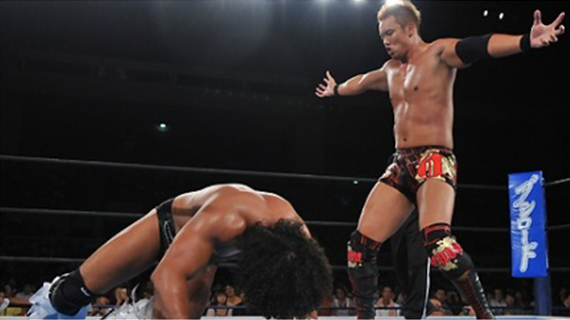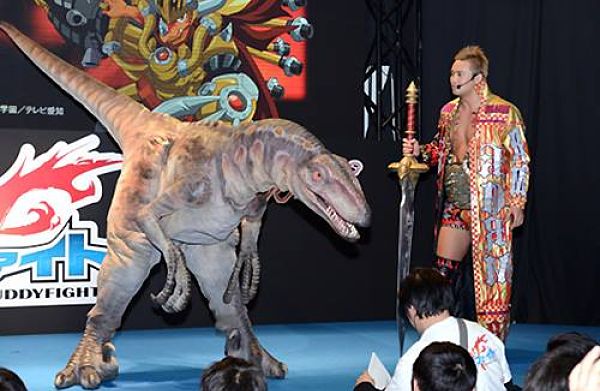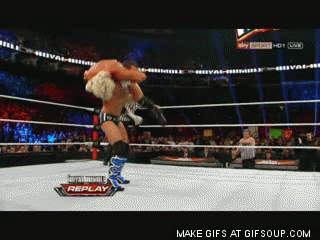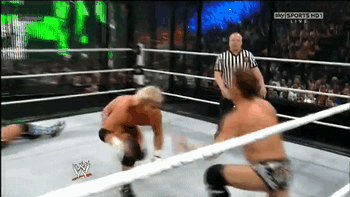
Kazuchika Okada stalks his prey. (Source)
Pro wrestling is a weird bastard art, and if you’re unfamiliar with its intricacies, the hordes of people in your social media circles obsessively pontificating about it every Monday night must be a truly confounding experience. Let our very own Dominic Griffin, lifelong wrestling enthusiast, teach you a little something right here, In This Very Ring…
Whenever I watch wrestling with non-believers, one of the most difficult things to get across is the function of finishing moves. It’s hard enough getting people who aren’t fans to accept fake punches and kicks, but then when they’re also expected to believe One Final Move is enough to death murder kill a man into unconsciousness, it goes into overdrive.
Finishing moves are a necessary storytelling tool. They serve multiple purposes within the confines of a wrestling match. For a performer, a finishing move is like a calling card. It gives the fans something to get pumped for, particularly if the move comes with some anticipatory theatrics, like Shawn Michaels’ Sweet Chin Music superkick, a quick striking move preceded by suspenseful moments of Shawn stomping his foot on the mat, “tuning up the band” for the big climax.
A finisher that needs no preamble can be just as effective. Both yoga enthusiast Diamond Dallas Page and tanning oil spokesman Randy Orton saw great success with their respective Ace Crusher[1] variants, the Diamond Cutter and the RKO. Having a move that can be hit out of nowhere injects a sense of spontaneity into the rhythms of a match, ratcheting up excitement levels. Everyone loves a surprise.
Knowing the finishers of two wrestlers engaged in a match leads to all sorts of great storytelling potential. Two capable performers will build intrigue from reversals, near misses and false finishes, creating new physical drama from the give-and-take relationship between their respective movesets. There are countless examples of this kind of wrestling, but a personal favorite is from the 2011 Royal Rumble, where Dolph Ziggler reverses CM Punk’s GTS (Go To Sleep, a fireman’s carry into a knee strike to the head) into the Rocker Dropper, a flying leg bulldog. I could watch this .gif forever.
The thing about finishers is they have to evolve as the business changes. Back in the 50s, a body slam was impressive enough to end a match. Not so much these days. As fans become desensitized towards certain displays of violence, it takes innovation to shock their minds into comprehending a credible amount of devastation. Take Jake “The Snake” Roberts’ DDT, a legendary finisher purported to have been birthed out of a botched side headlock. A master of ring psychology, Roberts was particularly adept at building suspense for the DDT and protecting it’s mystique. You see, a finisher has to be protected to some degree to maintain its potency. If multiple guys are seen recovering from this move only moments later, the move can no longer be taken seriously. Most finishers die from this exact issue, but the DDT ceased to be a force once other wrestlers began using it as a transitional move. If one man uses a move to set up an even bigger move, it dilutes the original move. Many of the finishers of yesteryear, your power slams and your sleeper holds, just don’t cut it anymore.
Unfortunately, this kind of finisher fatigue has led to a Lensman’s arms race of successively dangerous new finishing moves, particularly on the indie scene, where hungry young performers are likely to devise all manner of convoluted locks, holds, and strikes to stand out. Whereas audiences of old might go insane for The Great Muta’s picture perfect moonsault, modern audiences might yawn. Ricochet performing a dangerous and rare double rotation moonsault, though? That’ll do the trick. A lot of the indie guys start with the head-dropping mechanism of the DDT or the piledriver and take them to new heights of spinal cord-rattling severity, a trope born from mid 90s All Japan matches.
Wrestlers like Mitsuharu Misawa, Kenta Kobashi and Toshiaki Kawada wrestled one another so frequently during their heyday that, over time and to keep things fresh, they would develop superfinishers to take their matches to the next level. A superfinisher being employed in a match was like the sword moment from Pacific Rim, a “bigger gun” reserved for special occasions. To illustrate, I present a video of the seven solitary times Kobashi used the Burning Hammer to win a match. If you’re wondering why only seven, take a look at his opponents’ necks.
Or take a look at Kawada’s Ganso Bomb, a botch effectively sold as the most risky wrestling move ever.
The problem following in the footsteps of these greats is twofold. One, You Could Die. Kobashi and company all explicitly trusted one another and were a very tight knit group, but even with their safety precautions, wrestling matches like these shortened their careers. Misawa died in the ring from a “routine suplex” because he spent the majority of his career being dropped on his skull. One of wrestling’s greatest artists ever, lost, for giving up too much of himself. Secondly, where do you go from here? If every generation of wrestlers has to top the finishers of their predecessors, Wrestlemania 40 is going to end with someone getting shot in the fucking face.
The truth is, innovative offense doesn’t always mean “excessive force.” Sometimes you just have to look at things from a different perspective. Chris Jericho spent the majority of his career using the Lion Tamer/Walls of Jericho as his primary finisher, a variation of the Boston Crab, a leg lock where one’s opponent lays on his stomach and has his legs bent behind his back with the aggressor’s weight being pressed down on his spine. Jericho specialized in bending his usually flexible junior heavyweight competition into pretzels, like so:
As he moved up the card and found his competition less suited to being put in this hold, he sought out a new finisher. Using a submission hold as a finisher worked perfectly for someone like Bret Hart, “The Excellence of Execution,” because his character was that of a proficient technician who knew how to out-wrestle anyone. It similarly fit the cocky, younger iteration of Jericho’s persona, but when he shifted into his “Best There Is” character, heavily influenced by Anton Chigurgh from No Country For Old Men (albeit with Wolverine’s signature catchphrase), he began using the Codebreaker, a front facebuster driving his opponent’s skull into his knees, like so:
It offered him a new lease and added more rooms to the house, so to speak, altering the expected rhythms of his in-ring work.
Indie technician/Chikara founder Mike Quackenbush, a world-traveled worker, took a different route, adding multiple versions of his finisher, the Quackendriver, to his repertoire. Noting them by the QD1, QD2 naming convention helps fan differentiate them, and he employs the different variations depending on the match, the circumstance and the opponent.
What finisher a wrestler uses can affect their popularity. The Undertaker may not have lasted the decades he did without the Tombstone Piledriver. In other cases, like with Hulk Hogan’s legendary but benign leg drop finisher, the man makes the move. Only someone with as grand a presence as Hulk Hogan could make dropping his thigh across your chest seem like a kill shot. Bigger men, like The Big Show or Mark Henry, can get away with using a knockout punch and a power slam, respectively, to end matches, due to their size.
Sometimes innovation and execution are all it takes to make a great finisher. Take Athena, Wrestling Goddess, Hussy Destroyer, one of the finest in ring talents on the planet. Athena’s finisher is appropriately called The O-Face. It’s a diving cutter off the top rope that lands in a stunner. I haven’t the words to describe it’s grace, so I will let YouTube do the talking.
In the case of Athena, her finisher got people talking about her work. You’d look her up just to see this sick move people kept talking up, but then you’d stick around to watch one of the hungriest young wrestlers in any promotion consistently upping her game every time she steps through the ropes. For Athena, a dope-ass finisher is just a metaphor for her passion in the ring.
For two of my personal favorite wrestlers working today, Daniel Bryan and Kazuchika Okada, a great finisher was the punctuation mark on a transition from being Really Damn Good to being The Fucking Man.
Bryan had long used a variety of submission holds as his finisher, predominantly the the LaBelle Lock, an MMA-style crossface very similar to the one used by the late Chris Benoit. As with Jericho, Bryan needed a new finisher to mix things up. Being a main event-er with a submission finisher limits your options, as you need to be able to win matches without making other top guys look weak by submitting or tapping out. Bryan began using a running high knee, a striking move that could come from nowhere and blindside any number of opponents, knocking them out without making them look like chumps. The move instantly became over (editor’s note: remember, “over” is good) after he used it to beat John Cena, one of the most untouchable figures in WWE history, at Summerslam last year.
Kazuchika Okada, the young ace of New Japan Pro Wrestling, is one of the youngest top guys in the business. After years “studying abroad” and working in the States at Total Nonstop Action (WWE’s biggest competition in the US[2]) Okada returned to his home promotion, a rookie in need of reinvention. He had never been particularly spectacular in any regard, but biding his time in America left with him a lot of ideas on who he could become if given the opportunity. Okada was reborn as Rainmaker, a living, breathing Capcom character, larger than life, a contender.

Yes, this is Okada with a dinosaur. (Source)
He exhibited preternatural charisma, a great ear for crowds and how to appeal to them as either a hero or a villain, and a physical presence few of his peers could ever match. Okada took the world by storm when he unseated IWGP World Champion Hiroshi Tanahashi (for lack of a better comparison, the Japanese John Cena) at New Beginning 2012, taking him down with his new finisher, The Rainmaker. Now, having a move named after your own moniker sounds weird on paper, but the finisher, not much more than a theatrical clothesline, is a thing of beauty. He executes it with such force and such elan. What sets it apart as maybe my favorite finisher in wrestling is the selling example set by Tanahashi. The way he flips and folds his own body up like a broken accordion makes the move seem like legit murder.
To see a king like Tanahashi destroyed by so simple a move gave an up-and-comer like Okada serious credibility. In the ensuing back and forth series between the two competitors, the threat of The Rainmaker loomed like the shark from Jaws, sudden and tangible death just waiting around every corner. It took Okada from being a young nobody to the winner of multiple awards, championships and accolades, including, allegedly, being scouted by the WWE.
When Okada began being referred to as a big fish in a small pond staying in New Japan, he was offended. To him, NJPW is just as big as the WWE, as big a dream for him as WWE was for Daniel Bryan.
I have heard people say that if I stay in Japan that I will be a big fish in a small pond, but I do not agree. If people think Japan is a small pond, then I will rebuild the pond with my own hands and make it as large as the Pacific Ocean.
Okada has spent the last few years doing just that, all on the strength of One Final move.
[1] The Ace Crusher is a cutter invented by otherwise miserable wrestler Johnny Ace in the 90s. The performer stands in front of his opponent, back to him, grabs his neck and drives his body into the mat. Steve Austin’s variant, the Stone Cold Stunner, is perhaps the most infamous.
[2] TNA is competition, but only because there are so few wrestling promotions with television deals. Imagine if WWE was Marvel, and there was no DC or Image. TNA would be a shitty version of Valiant.
Follow @DeadshirtDotNet and @captain_fuck on Twitter where we’ll be available to answer any possible question you could have about wrestling.






